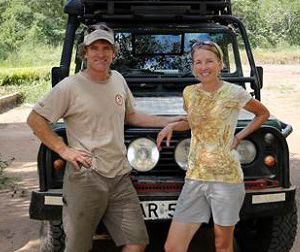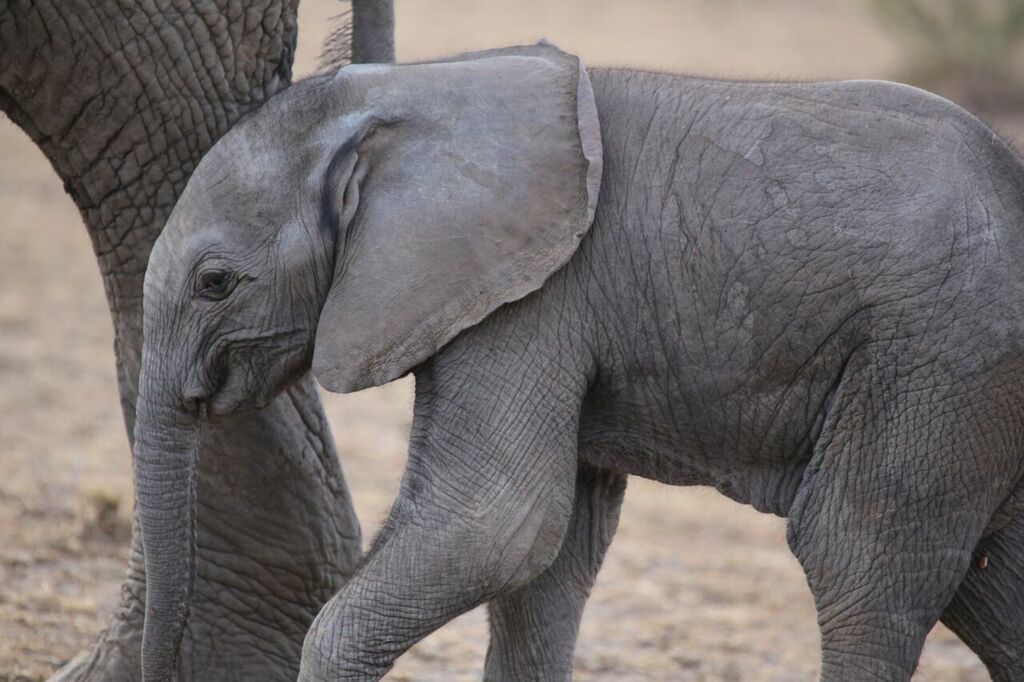Little “E”
By Gina Poole
Sometimes the unexpected happens. Two weeks ago while driving through the Conservancy looking for elephants Bob spotted the telltale flapping of ears high up on a hillside. We drove closer to get a better look when, through my binoculars, I got a fleeting glance of a very small elephant. It disappeared behind the croton bushes but I knew it must have been quite young given the pinkish hue of its ears. The calf was in a steep, rock-strewn area that was inaccessible by vehicle. As it was getting late we returned to camp and decided to attempt to find the calf the next day.
A new addition
Setting out early with anticipation we learned through our ranger contacts that a small calf had been seen to the east of our camp. We headed in that direction and were rewarded with the sighting of an elephant family that had a little calf with them. The mother’s hind legs were still wet from the birth that we estimated had occurred less than 48 hours earlier. The calf was very wobbly; its head hung low, and its red eyes held an unfocused gaze of having just entered this mysterious new world.
The newborn elephant was a male, with a crooked tail, and ears with creases from being in the womb for 22 months. We decided to name him after our friend and colleague, Emre, and “Little E” would be our constant companion over the next two weeks.
Caretakers
When a calf is born into an elephant family, there’s interesting behavior that we hoped to film and Little E didn’t let us down. Elephant calves are very vulnerable and completely dependent on their mothers, especially during the first three months, for the life giving milk they provide. The complexity of elephant development is reflected in how calves depend on their families for security, comfort and socialization. Earlier this month we filmed a small calf who had lost his tail and had several scars on his right hind leg, most likely from a hyena attack, and one can only imagine the fierceness in which his mother and other family members defended his young life. He survived the ordeal; his wounds were completely healed and he was doing well.
Precious cargo
In Little E’s case, his aunt who did not have her own calf, assumed the role of “allo mother” helping his mother to raise him. He was never more than a trunk’s reach away from either his mother or allo mother. They constantly made sure he was close to them, by gently touching him with their tails, trunks and feet. The compassion was extraordinary and wonderful to watch, as his mother and auntie would reassure him with their trunks, making coo rumbles to him and even pushing aside a fallen branch to make his nap a bit more comfortable. While crossing a river drainage that was full of slippery surfaced rocks, his mother and allo mother carefully aided him by guiding his movements with their trunks, ensuring he made it safely to the other side.
I think there’s probably nothing cuter than an elephant baby and each morning we looked forward to finding him so we could spend as much time as possible filming his development. It wasn’t’ too difficult to locate the family as the matriarch and other members of his immediate family stayed close by and didn’t travel far during these early days. The pace of life slowed down and they contented themselves by eating, sleeping and catering to the needs of Little E.

The future of elephants
We learned from Joyce that Little E’s family isn’t from Naboisho, but were passing by when he was born here. I’m relieved that he is in Naboisho, under the protection and safety of the Conservancy. We see too many elephants migrating through who show the signs of human conflict: arrow wounds, some healed, others still open. How secure is his future? That’s the big question and one that we grapple with given current pressures on elephants. It’s all the more important for places like Naboisho to succeed so that not only Little E, but also others can survive. By visiting Naboisho, your tourist dollars make a real difference in assuring that these vital ecosystems remain intact for years to come.
Watch the trailer for “Little Giant” here.
To find out more please contact your trusted travel agent or enquire here. In the meantime, you can follow Bob and Gina Poole’s experiences at Naboisho on this blog and Naboisho Camp’sFacebook page.
 About Gina & Bob Poole
About Gina & Bob Poole
No strangers to Naboisho, Bob has previously documented the life of a cheetah family in the conservancy. At Naboisho they will be following a family of elephants on their journey for a film for National Geographic WILD.
Find out more on their website.
The post Little “E” appeared first on Asilia Africa.
More Wildlife & Conservation Articles

Leopard vs Cheetah : Can You Tell The Difference
01 April 2020How often do you mistake a leopard for a cheetah or vice versa? I’m sure we’v...

What’s the difference? National Parks, Game Reserves, and Conservancies in East Africa
02 February 2020To most of us, a national park, game reserve, or conservancy are all the same...

Electric Vehicles: The Future Of East African Safari Travel?
12 January 2020October 2019 saw the arrival of our first electric, solar-powered safari vehi...

Guest Gallery: The Serengeti At Its Best
27 November 2019We recently had the pleasure of welcoming guests, Chris and Monique Fallows t...







